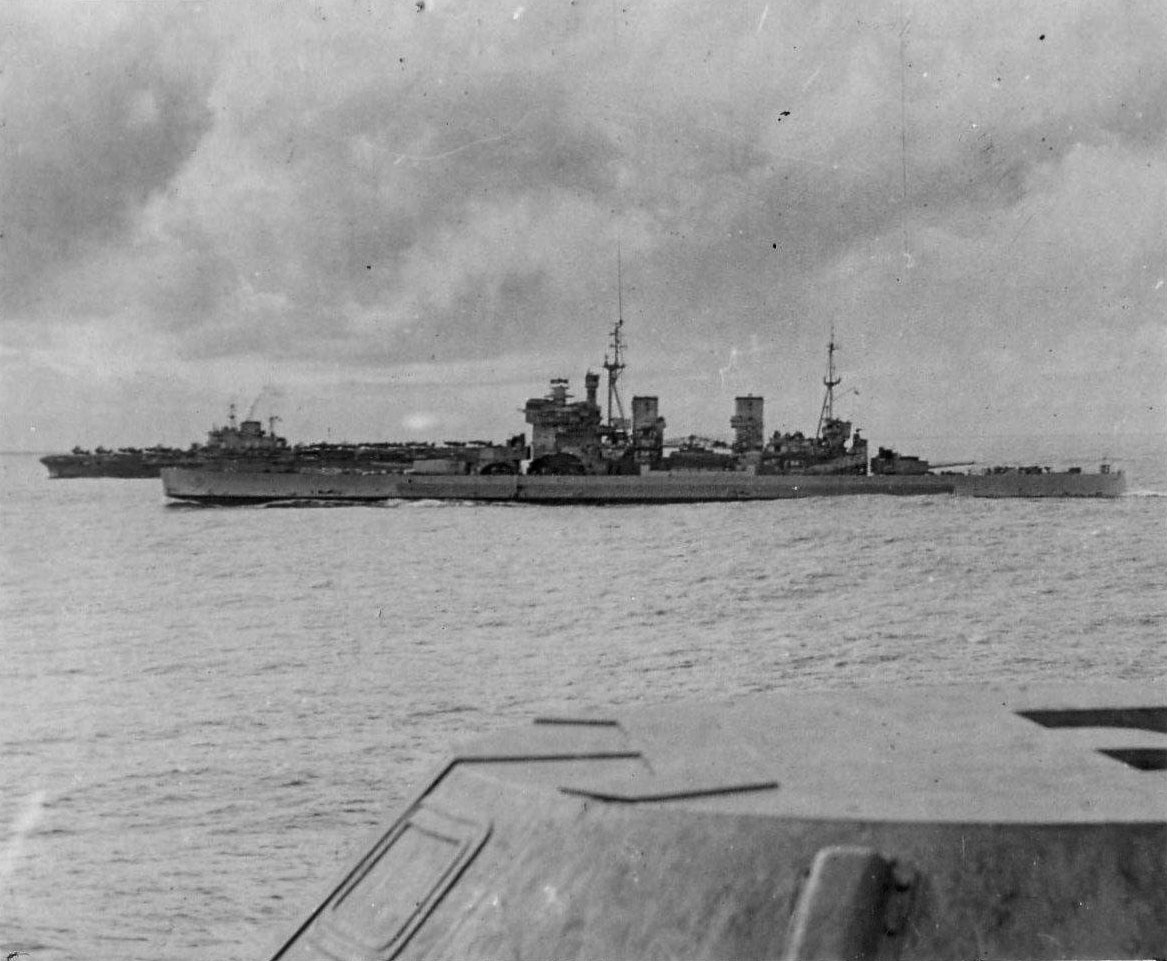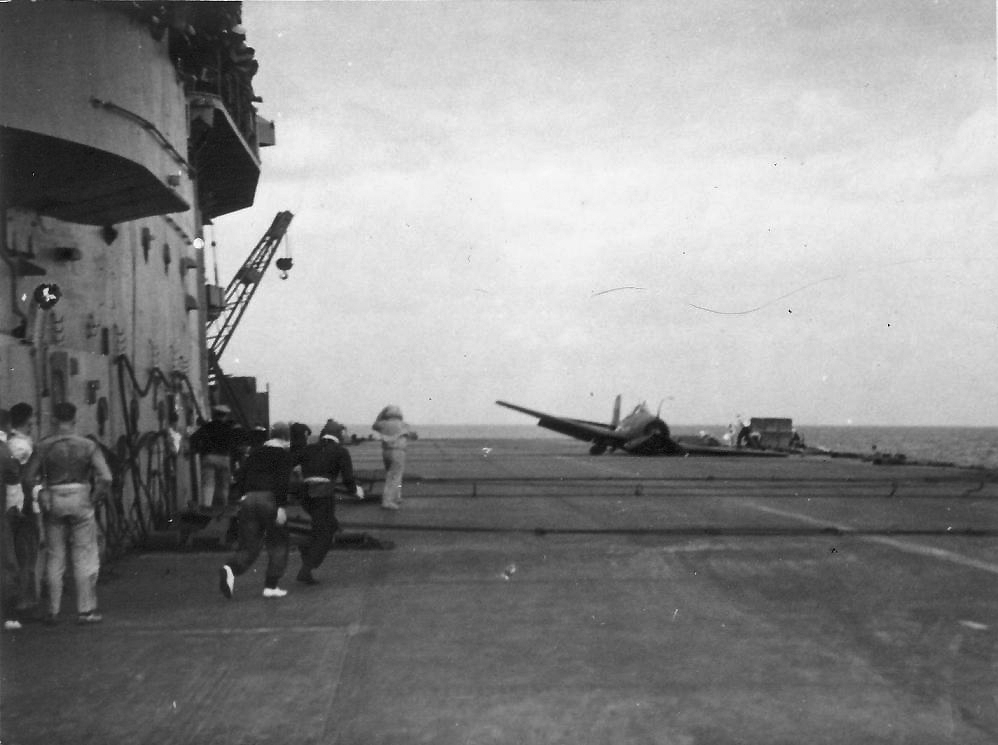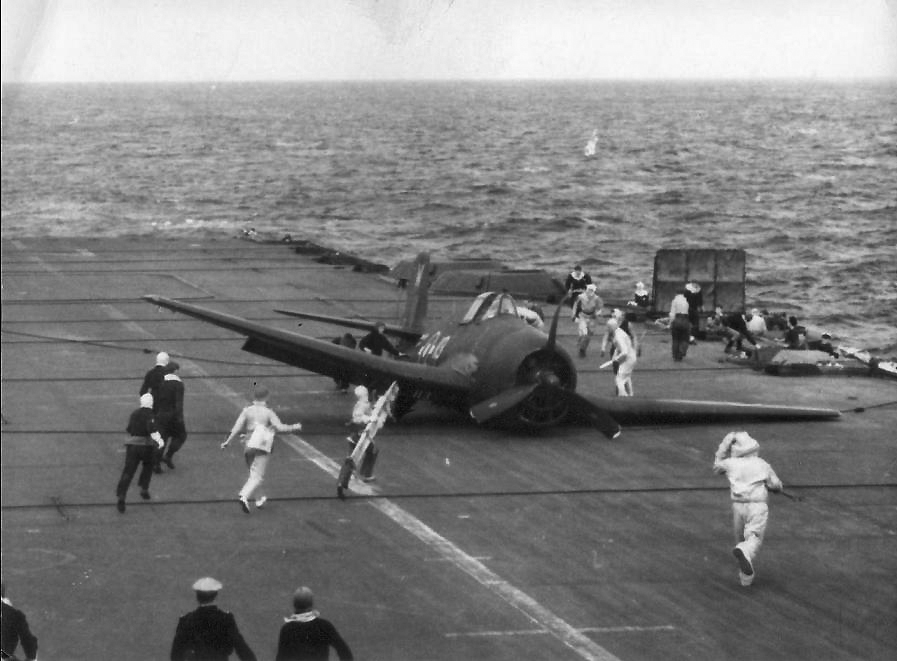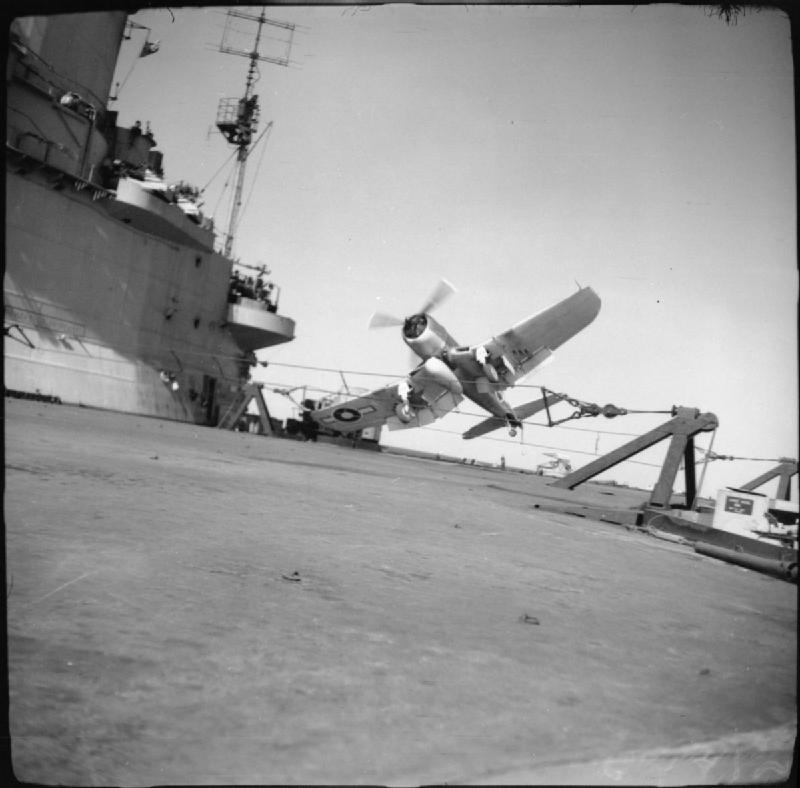Diversion
Vice-Admiral Vian saw the diversion to Formosa as the British Pacific Fleet's most important action. He was determined to succeed:
“For a time, the number of American ships being damaged by Kamikaze attacks led to fears that all naval forces would have to retire unless the situation improved. It was at this stage that Admiral Spruance decided to re-allocate Task Force 57 to supplement the efforts of the land-based Air Forces of General MacArthur’s South-West Pacific Area. In the absence of a unified Command in the Pacific, MacArthur had been requested to cooperate by maintaining attacks on the airfields of Northern Formosa, from which many of the aircraft attacking the ships off Okinawa were coming. MacArthur considered this a waste of effort, and maintained his view in spite of appeals from the commander of the 5th Fleet. This was to cause bitterness in the Fleet concerned, many of whose casualties were undoubtedly being caused by attacks from Formosa.
It had long been apparent that the aircraft based on Formosa were far more skilfully handled than those coming from Kyushi, the pilots of many of which were thrown into action half trained. They had inflected considerable damage on ships off Okinawa, as well as on Task Force 58. Now, therefore, the British Task Force was given the job of raiding the two main airfields in the northern part of the island, Shinchika and Matsuyama.
AT 0600 on April 11, Task Force 57 was ready to begin operations against Formosa from its staging point some 100 miles south-east of Matsuyama for 24 hours.
The weather was not about to let them. Solid cloud sat at 1000ft and patchy rain and drizzle reduced visibility beneath that height to little more than a mile. The conditions had grounded even the seagulls, as the old salts would say.
The Task Force moved in a bid to find a break in the cloud, without luck.
Admiral Vian was keen to attempt some form of strike and planned a small RAMROD mission to Schinchiku. However his staff actively attempted to dissuade him due to the poor chances of the aircraft finding their carriers again and the minimal value gained for the resulting loss of surprise.
He relented. The operation would be postponed by 24 hours.
As they waited, rumours of another massed kamikaze attack on Task Force 58 flashed through the British fleet. Once again it was the radar picket ships that had suffered the most, but USS Essex and Enterprise has sustained several near-misses.
April 12
The first 16 CAP fighters flew off at 0600. These were broken into sections of four: One section loitered close to the fleet at 3000ft, while the remainder was spaced at 6000, 10,000 and 20,000ft.
It was not long before the first enemy aircraft were encountered.
At 0704 the fleet failed to detect a four Japanese aircraft flying at 6000ft at 35 miles range. They were spotted, however, by a section of four Seafires of 887 squadron. Expecting USN aircraft in the area, the Seafires approached carefully to confirm identification. The aircraft were determined to be three Zekes and a Ki61 Tony.
The Japanese saw the approaching Seafires and dove towards the sea, splitting into two flights. The Seafires gave chase. Sub Lt J H Kernaghan fired two long burst at a diving Zeke. It caught fire and flew into the sea. Kernaghan then turned his guns on the Ki-61 “Tony” which he damaged before running out of ammunition.
Being in a poor position because of their caution, the Seafires were unable to catch the fleeing survivors. Their Seafires were older production models issued as replacements. They were equipped with the original reflector-style gun sights, not the gyro lead-computing sight that the pilots were now used to flying with.
On the other end of the caution spectrum, a Seafire of 887 squadron was sent after a contact amid cloud and rain. He opened fire at long range, but scored no hits. Upon closing, he discovered – to his horror – that the aircraft was a PB4Y Liberator running with its IFF turned off.
At 0715 a two strikes of 24 Avengers were sent off towards the airfields. They were escorted by 40 Corsairs and had a projected time-over-target of 0900.
Flying at low level because of heavy cloud above 2000ft over land, the Avengers of 820 and 857 Squadrons eventually found and bombed Shinchiku. No enemy fighters were encountered but the defensive flak was found to be intense and accurate.
Matsuyama airfield was covered by low, heavy cloud. Circling out to sea, 849 Squadron and 854 Squadrons were diverted to the secondary target of Kiirun harbour. They dropped their bombs on the docks, factories and shipping they found there.
One of 849 Squadron’s Avengers failed to return from this raid.
A pilot of 1833 Squadron also was forced to ditch while escorting a strike over Formosa. ASR aircraft would search for the remainder of the day, but he was not found.
Petty Officer R J W Gibbs of Indefatigable’s 820 Avenger squadron had been hit by flak. His observer had been wounded and a fire in the starboard wing fuel tank was spreading to the cockpit. Gibbs and his gunner managed to extinguish the fire, bandage the wounded observer and repair the damaged radio set. He directed the pilot back to the fleet where his Avenger was able to land safely and the wounded man was given urgent medical treatment.
The Hellcat and Corsair escort also strafed industrial sites and shipping, paying particular attention to the rail facilities. They also destroyed a bridge near Matsuyama.
One of HMS IMPLACABLE'S FireFlies. Very few photographs were taken of this type during the BPF deployment.
Two Fireflies of 1770 Squadron had been assigned to escort an American ASR “Dumbo” aircraft - in this case a Mariner flying boat - near Yonakuni Shima. They had the best luck of the day. Five Ki51 “Sonia” single-engine dive bombers were sighted flying towards Task Force 58 to the east. The Fireflies intercepted and shot down two bombers each. The fifth was reported as heavily damaged. A Sonia – possibly the damaged aircraft – was seen to land on Yonakuni Island. It was later destroyed by a Corsair.
The action produced the war’s only Firefly ace: Sub Lt Phil Stott, who also had claimed three shared victories over Sumatra.
The fleet’s fighter control leader, Commander E D G Lewin aboard HMS Indomitable, also was kept busy.
Indomitable’s US supplied SM-1 radar proved better at finding heights than the older Type 277 radar fitted to the rest of the carriers.
At 1115 a reconnaissance Dinah was chased from 19000ft down to sea level by a flight of Illustrious’ Corsairs. The heavy fighters had jettisoned their drop tanks to ensure they could close the range.
The fighter directors were not so successful at 1410 when another Dinah with an escort of two Oscars managed to avoid interception.
But victory would come once again at 1530 when a Hellcat caught and shot-down a Zeke to the north-west of the fleet.
The main attack of the day was launched at Task Force 57, ironically, from Ishigaki.
ATTACK OF THE FIREFLIES
One journalist with the Task Force 57 wrote the following account of the interception by HMS Indefatigable’s 1770 Squadron Fireflies of five Japanese Sonia single-engined bombers on April 12:“Killed a plane a minute. Two North of England Navy pilots flying Fairey Fireflies from the carrier Indefatigable bagged four Jap planes in as many minutes in a spectacular dogfight at almost water level in the Pacific early in April.
The pilots, Sub Lieutenant Walter Thompson, of Cleator Moor, Cumberland, and Sub Lieutenant Philip Stott, of Liverpool, were escorting an American flying-boat rescuing ditched air crews from dangerous waters around Jap held islands in the Formosa area, when Thompson’s Observer, Sub Lieutenant Eric Miller, of Newcastle, spotted five Japanese Sonias a few miles away.
Closing immediately the Fireflies attacked at such close range that Thompson’s windscreen was covered with blazing oil when one of his victims tried to get down to sea level.
The fifth Sonia escaped into the clouds.”
Fighter controllers detected the incoming raid and vectored the CAP to intercept. In an action lasting some 10 minutes, three Hellcats shot down four Oscars and a Tony. One of the Hellcats was so seriously shot-up that it crashed as it attempted an emergency landing aboard Indomitable – killing its pilot. Illustrious and Victorious’ Corsairs were also involved in the engagement, downing a Val dive-bomber and an Oscar/Zeke.
Lieutenant Commander J.B. Edmundson of Victorious was flying his Corsair II as CAP leader:
His flight spotted what he reported as two Zekes and a Val at 7000ft:
“The enemy aircraft were flying very slowly at about 120 knots and one of them was carrying out the most erratic and peculiar evasion. Two aircraft escaped, but the Zeke we splashed dived down to sea level instead of going up into the cloud which was the obvious evasion. If stories of doping are true, then I reckon that this pilot was well and truly doped.”
The final day’s score was 16 Japanese aircraft claimed shot down in return for the loss of three FAA aircraft.
Despite Task Force 57 efforts, Admiral Rawlings received reports that the US fleet off Okinawa was again experiencing heavy attacks. A second “kikusui” had been launched to coincide with the start of a two-day counterattack by the Japanese on Okinawa. The battleships USS Idaho and Tennessee were hit and the destroyer USS Mannert Abele sunk. A further 10 ships had been damaged.
Rawlings, encouraged by the performance of his fleet that day, signalled Spruance offering an extra two days operations off Sakishima Gunto to interdict that portion of the kamikaze raids.
Admiral Rawlings later wrote:
“I came to the conclusion during that evening that we must contrive to remain for a further period; even if we could do little more than occasionally strike at the Sakishima Gunto, we should anyhow provide an alternative target to take some of the weight.”
That night, TF57’s radars tracked a lone Japanese aircraft conducting a “box search” flight pattern, clearly looking for the fleet. It failed.
April 13
Dawn broke on a day with much improved weather.
Task Force 57 detected four bogeys at 0545 and four Hellcats were quickly scrambled. They were unable to reach the incoming enemy aircraft before they entered the fleet’s defensive flak zone.
In an bid to confuse the fleet’s defences, one Japanese aircraft switched on its navigation lights and fired an incorrect recognition flare – probably in the hope of confusing the gunners enough to make them fear the shadowy aircraft in the pre-dawn gloom was American.
The D3A Val dive bombers made their attack run, followed by one Hellcat pilot who had ignored the order to keep clear of the fleet’s anti-aircraft zone. His big radial aircraft was mistaken as Japanese in the early morning light and was shot down.
A Val made an unsuccessful attack on HMS Indomitable: His 500lb bomb splashed into the sea harmlessly.
The fleet’s gunners were more responsive when a second Val approached. It was quickly shot down. The surviving two Val’s fled.
A second formation was detected at 25 miles an hour after the first raid. Fighters from 1830 Squadron were vectored towards the contacts and destroyed two Zekes.
The attacks delayed the Avenger strikes only a short time. Two raids were launched at 0645 and the Shinchiku and Matsuyama airfields were once again the focus of the FAA’s efforts. Among the targets of opportunity hit were an aircraft on the ground at Giran (later judged to have been a dummy), a barracks and a petrol dump. Victorious’ Major Hay ‘caught a passenger train which was skulking in a tunnel but rather carelessly had left the engine sticking out’.
Eyewitness account: Waite Brooks, The British Pacific Fleet in World War II: An Eyewitness Account (aboard King George V).
Friday the 13 th had a number of people convinced that it was going to be a “hot” day. They were not far off the mark. A bogey joined us almost immediately and it appeared that the reconnaissance plane knew where we were and was homing the attackers. It was still dark and we had limited night-fighter capability. The attacking planes, estimated to be four in number, closed to within six miles when Indomitable flew off four night-fighter Hellcats. The Hellcats kept their navigation lights on for identification purposes and, immediately, the Japanese did the same. A Val, a Japanese navy dive-bomber, with its navigation lights on, dived at Indomitable and released its bomb. The bomb struck the carrier , but Friday the 13th was working in the ship’s favour and the bomb failed to explode. On the other hand, Friday the 13th was working in the Val’s favour and the ship did not open fire until it pulled out of its dive and was recognized as an enemy aircraft, by which time it was safely away. A few minutes later, a Hellcat flew over the carrier and was immediately shot down. A Zeke was flying above the fleet when it was detected by one of the carriers, which opened fire. It left the fleet at high speed, but not before dropping a flare over the ships. Victorious detected another plane overhead, opened fire, and shot it down. To the north of us, a small group of bombers was intercepted by Corsairs from Illustrious.
The Fireflies also got a taste of action once again while on their ASR CAP duties, this time by rocketing a radar station at Yonakuni Shima.
While the fleet made a series of radar contacts, the CAP had no further action.
Task Force 57 disengaged and retired to the south-east to replenish.
As the fleet made its way towards its rendezvous, radar operators about midday detected three aircraft to the north at a range of about 40 miles. CAP Hellcats spotted the fighters which they identified as Zekes, but were unable to close within firing range.
Victorious’ Corsairs also attempted to catch a Dinah with its escort of Tojos. These escaped into cloud.
Despite the fact that Task Force 57 was desperately short on aircraft, spares and supplies, Admiral Rawlings made his offer for another two-day round of strikes on Sakishima Gunto.
That night Admiral Spurance happily accepted the offer.
Some commentators say this was the point at which Spruance became convinced that his defence of the BPF’s capabilities had been the correct call.
Spruance's reply read:
“This is fine initiative and cooperation. Cover Sakishima 16 and 17 April unless otherwise directed prior to that time.”
The success of Iceberg Oolong– at such small cost – had come as a relief to Admiral Spruance. He would tell Admiral Rawlings later that:
“He had kept his fingers crossed the whole time.”
Also that evening, Task Force 57 heard of the death of President Franklin D Roosevelt.
MAJOR R.C. HAY
An Oolong mission action report, from Victorious’ 849 Squadron’s Air Group Leader“We took off to strike Matsuyama airfield, Formosa, at 0645 and departed at 0705 – surely a record! A landfall was made at 0730 with visibility of 30 miles and 10/10ths cloud at 6000ft. Cloud deteriorated over the hills so I ordered the strike to proceed round the coast. This they did, climbing to 8000ft. Unfortunately a solid layer of cloud built up right over the airfield and prevented a detailed examination of the target. The cloud layer was 1000ft thick with a base of 3000ft. I informed strike leader D.R. Foster and orbited overhead looking for a gap – he eventually decided to bomb after diving through cloud. From down below I observed many bombs striking the airfield until it was covered in brown smoke and dust. There was no flak before the bombing, but the moment the bombers appeared below 3000ft every gun went into action. They were obviously waiting. On withdrawal one Avenger bombed a factory. I caught a passenger train which was skulking in a tunnel but rather carelessly had left the engine sticking out. We then shot up a few junks and went on to Giran where approximately twelve aircraft of various types were spotted. One twin-engine plane was strafed but failed to burn. Considering the weather I think the strike was a fine piece of work. There was no jamming and radio discipline was excellent. No enemy aircraft were seen airborne.
Top, Q147 - one of HMS ILLUSTRIOUS'S 1830 Squadron Corsairs, bounced badly upon landing on April 13 before, above, nosing into the island.
April 14
Task Force 57 arrived at the RAS area “Cootie” in the early morning.
As the British Pacific Fleet once again set about replenishing its stocks of fuel, ammunition, food and aircraft, the low grey slab that was HMS Formidable lifted itself above the horizon.
Under Captian P. Ruck-Keene, Formidable was equipped with 848 Squadron’s 18 Avengers along with 1841 and 1842 Squadrons - each with 18 Corsairs.
HMS Illustrious had had enough. Not only had cumulative wear-and-tear and combat damage caught up with the carrier, her Corsair squadrons – active since December 1943 - had long passed the point of exhaustion and were showing dangerous signs of fatigue.
That afternoon, after transferring some essential personnel and equipment to the other fleet carriers, the tired old veteran would end her war and set course for Leyte with orders to return to Sydney and then Britain for repairs and a major refit.
Captain Lambe of Illustrious was to note that his ship had flown 505 sorties during ICEBERG, as well as:
"... embarked 3549 tons of fuel oil at sea, 88,363 gallons of Avgas aviation spirit (and) 50,000 sausage rolls.”
Aftermath
Vice-Admiral Vian regarded the OOLONG diversion to have been the British Pacific Fleet's most successful operation:
In the light of the relative weakness of our carrier strength this was a dangerous mission, and it was only ordered by Admiral Spruance in the face of necessity. He told me afterwards that he had kept his fingers crossed throughout the operation.
In the event, the raids, carried out in full strength on the 12 and 13th April, were successful. Considerable loss was inflicted on the enemy, and our own was moderate. Air attacks on the Fleet were less severe than had been expected, and no ships were damaged, whilst a number of attackers were shot down by our Combat Air Patrols.












